seats MERCEDES-BENZ B-CLASS HATCHBACK 2011 Owners Manual
[x] Cancel search | Manufacturer: MERCEDES-BENZ, Model Year: 2011, Model line: B-CLASS HATCHBACK, Model: MERCEDES-BENZ B-CLASS HATCHBACK 2011Pages: 329, PDF Size: 7.91 MB
Page 6 of 329
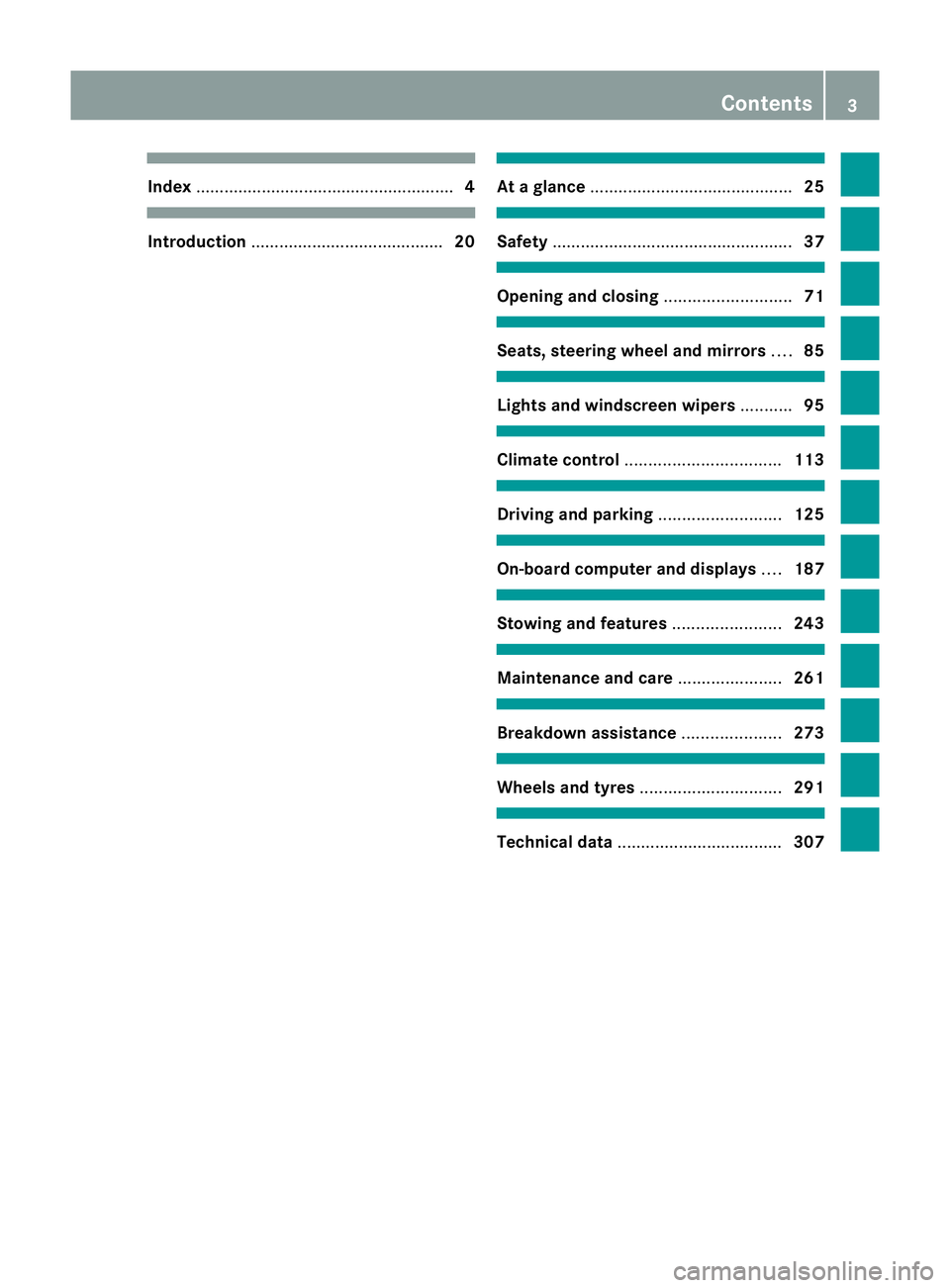
Index
....................................................... 4Introduction
......................................... 20 At
ag lance ........................................... 25 Safety
................................................... 37 Opening and closing
...........................71 Seats, steering wheel and mirrors
....85 Lights and windscreen wipers
...........95 Climate control
................................. 113 Driving and parking
..........................125 On-board computer and displays
....187 Stowing and features
.......................243 Maintenance and care
......................261 Breakdown assistance
.....................273 Wheels and tyres
.............................. 291 Technical data
................................... 307 Contents
3
Page 11 of 329
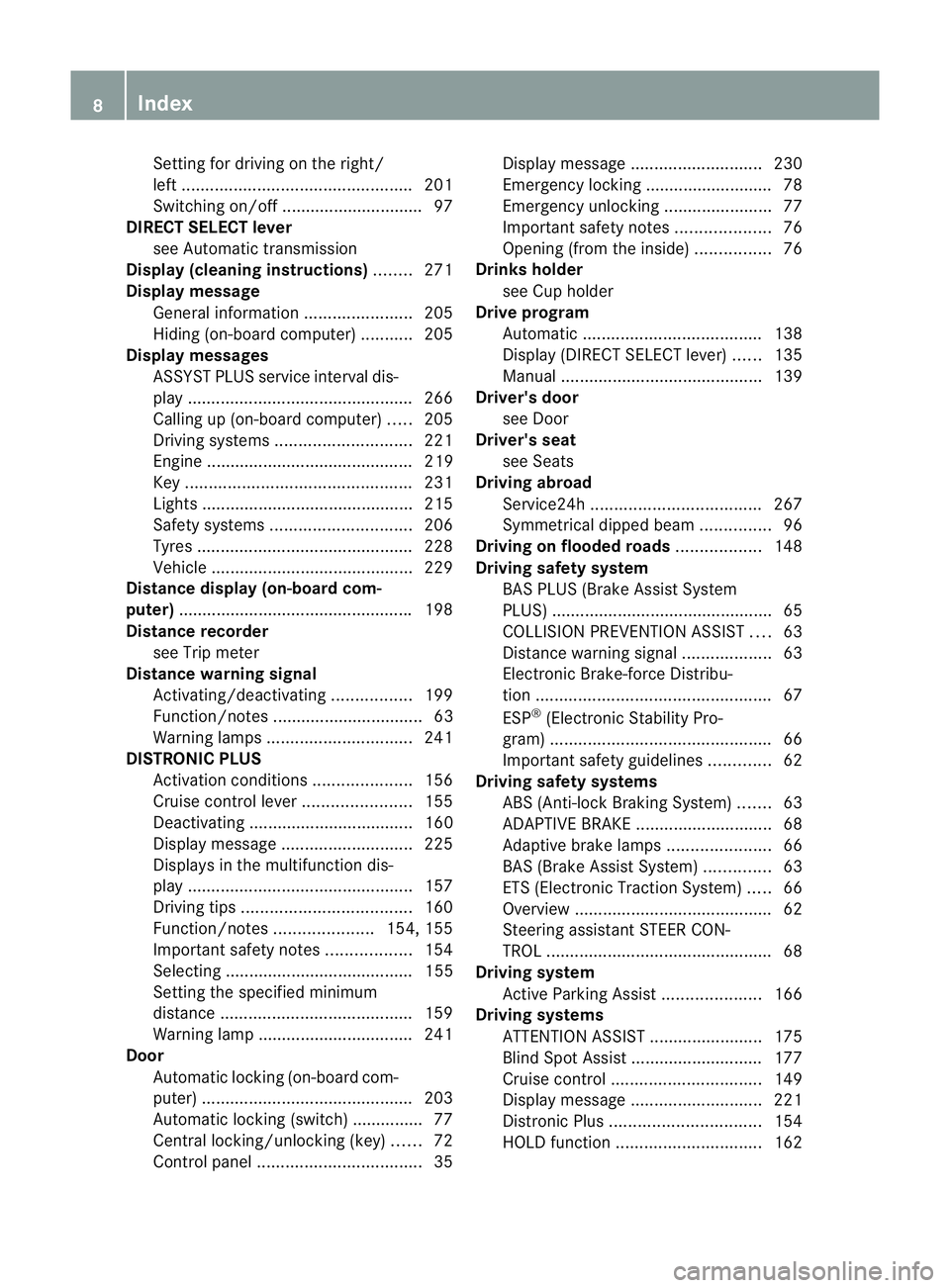
Setting for driving on the right/
left
................................................. 201
Switching on/off .............................. 97
DIRECT SELECTl ever
see Automatic transmission
Displa y(cleaning instructions) ........271
Display message General information .......................205
Hiding (on-board computer) ...........205
Display messages
ASSYST PLUS service interval dis-
play................................................ 266
Calling up (on-board computer) .....205
Driving systems ............................. 221
Engine ............................................ 219
Key ................................................ 231
Lights ............................................ .215
Safety systems .............................. 206
Tyres .............................................. 228
Vehicle .......................................... .229
Distance display (on-board com-
puter) ................................................. .198
Distance recorder see Trip meter
Distance warning signal
Activating/deactivating .................199
Function/notes ................................ 63
Warning lamps ............................... 241
DISTRONIC PLUS
Activatio ncondition s..................... 156
Cruise control leve r....................... 155
Deactivating ................................... 160
Display message ............................ 225
Displays in the multifunctio ndis-
play ................................................ 157
Drivin gtips .................................... 160
Function/notes .....................154, 155
Important safety notes ..................154
Selecting ........................................ 155
Setting the specified minimum
distance ......................................... 159
Warning lamp ................................. 241
Door
Automatic locking (on-board com-
puter) ............................................. 203
Automatic locking (switch) .............. .77
Central locking/unlocking (key) ......72
Control pane l................................... 35Display message
............................ 230
Emergency locking ........................... 78
Emergency unlocking .......................77
Important safety notes ....................76
Opening (from the inside) ................76
Drinks holder
see Cuph older
Drive program
Automatic ...................................... 138
Display (DIRECT SELECT lever) ......135
Manual .......................................... .139
Driver's door
see Door
Driver's seat
see Seats
Driving abroad
Service24h .................................... 267
Symmetrical dipped bea m............... 96
Driving on flooded roads ..................148
Driving safety system BAS PLUS (Brake Assist System
PLUS) .............................................. .65
COLLISION PREVENTION ASSIST ....63
Distance warning signa l................... 63
Electronic Brake-force Distribu-
tion .................................................. 67
ESP ®
(Electroni cStability Pro-
gram) ............................................... 66
Important safety guidelines .............62
Driving safety systems
ABS (Anti-lock Braking System) .......63
ADAPTIVE BRAKE ............................. 68
Adaptive brake lamps ......................66
BAS (Brake Assist System) ..............63
ETS (Electronic Traction System) .....66
Overview .......................................... 62
Steering assistant STEER CON-
TRO L................................................ 68
Driving system
Active Parking Assist .....................166
Driving systems
ATTENTION ASSIST ........................175
Blind Spot Assist ............................ 177
Cruise control ................................ 149
Display message ............................ 221
Distronic Plu s................................ 154
HOLD function ............................... 1628
Index
Page 18 of 329
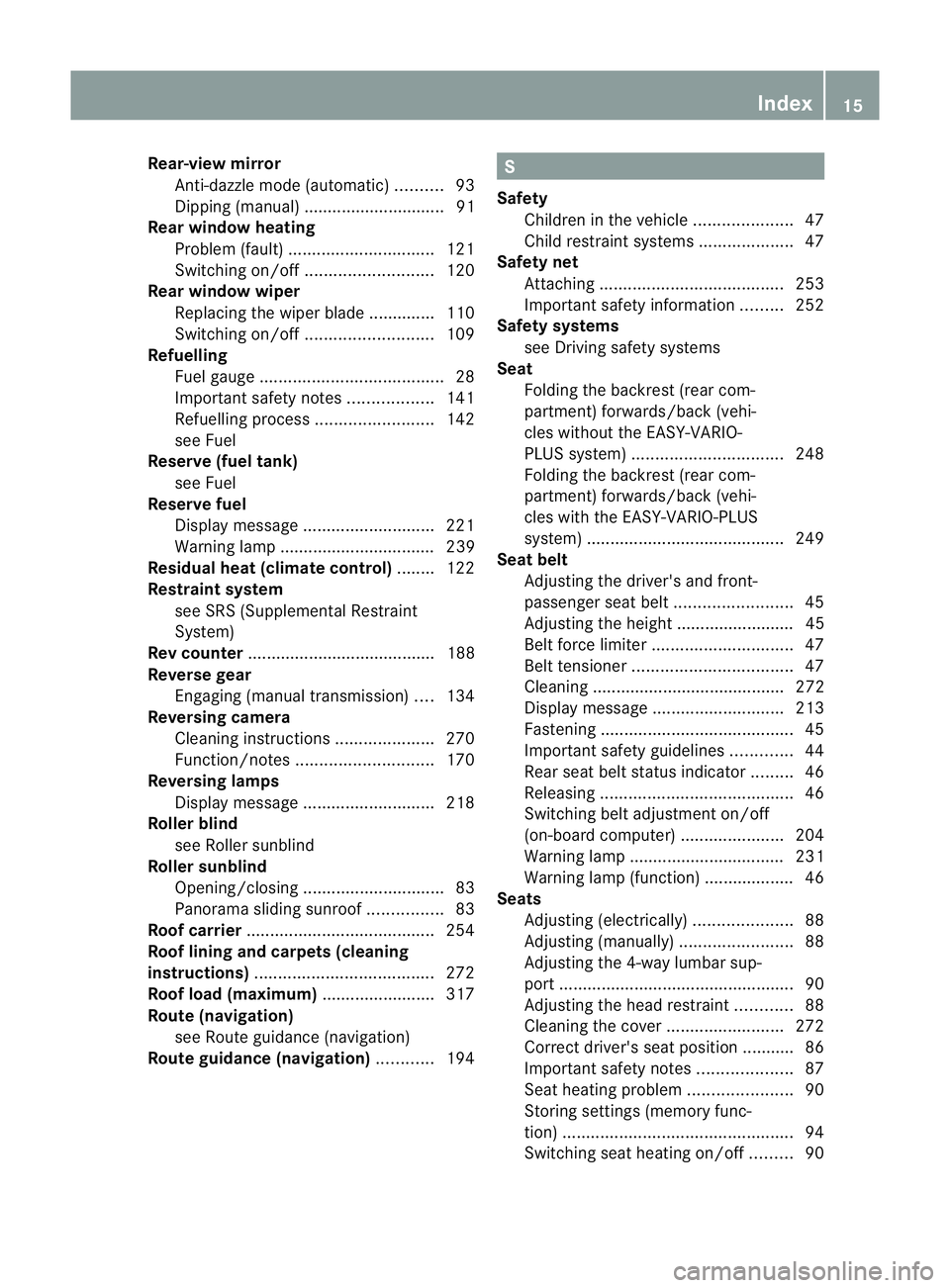
Rear-view mirror
Anti-dazzle mode (automatic) ..........93
Dipping (manual) .............................. 91
Rear window heating
Problem (fault) ............................... 121
Switching on/off ........................... 120
Rear window wiper
Replacing the wiper blade .............. 110
Switching on/off ........................... 109
Refuelling
Fuel gauge ....................................... 28
Important safety notes ..................141
Refuelling proces s......................... 142
see Fuel
Reserve (fuel tank)
see Fuel
Reserve fuel
Display message ............................ 221
Warning lamp ................................. 239
Residual heat (climate control) ........122
Restraint system see SRS (Supplemental Restraint
System)
Rev counter ........................................ 188
Reverse gear Engaging (manual transmission) ....134
Reversing camera
Cleaning instructions .....................270
Function/notes ............................. 170
Reversing lamps
Display message ............................ 218
Roller blind
see Roller sunblind
Roller sunblind
Opening/closing .............................. 83
Panorama sliding sunroo f................ 83
Roof carrier ........................................ 254
Roof lining and carpets (cleaning
instructions) ...................................... 272
Roof load (maximum) ........................317
Route (navigation) see Route guidance (navigation)
Route guidance (navigation) ............194 S
Safety Childre ninthe vehicle ..................... 47
Child restraint systems ....................47
Safety net
Attaching ....................................... 253
Important safety information .........252
Safety systems
see Driving safety systems
Seat
Folding the backres t(rear com-
partment) forwards/back (vehi-
cles without the EASY-VARIO-
PLUS system) ................................ 248
Folding the backrest (rea rcom-
partment) forwards/back (vehi-
cles with the EASY-VARIO-PLUS
system) .......................................... 249
Seat belt
Adjusting the driver's and front-
passenger sea tbelt ......................... 45
Adjusting the height ......................... 45
Belt force limiter .............................. 47
Belt tensione r.................................. 47
Cleaning ......................................... 272
Display message ............................ 213
Fastening ......................................... 45
Important safety guidelines .............44
Rea rseat belt status indicator .........46
Releasing ......................................... 46
Switching belt adjustment on/off
(on-board computer) ......................204
Warning lamp ................................. 231
Warning lamp (function) ................... 46
Seats
Adjusting (electrically). ....................88
Adjusting (manually). .......................88
Adjusting the 4-way lumba rsup-
por t.................................................. 90
Adjusting the head restraint ............88
Cleaning the cover .........................272
Correct driver's seat position ........... 86
Important safety notes ....................87
Seat heating problem ......................90
Storing settings (memory func-
tion) ................................................. 94
Switching sea theating on/off .........90 Index
15
Page 42 of 329
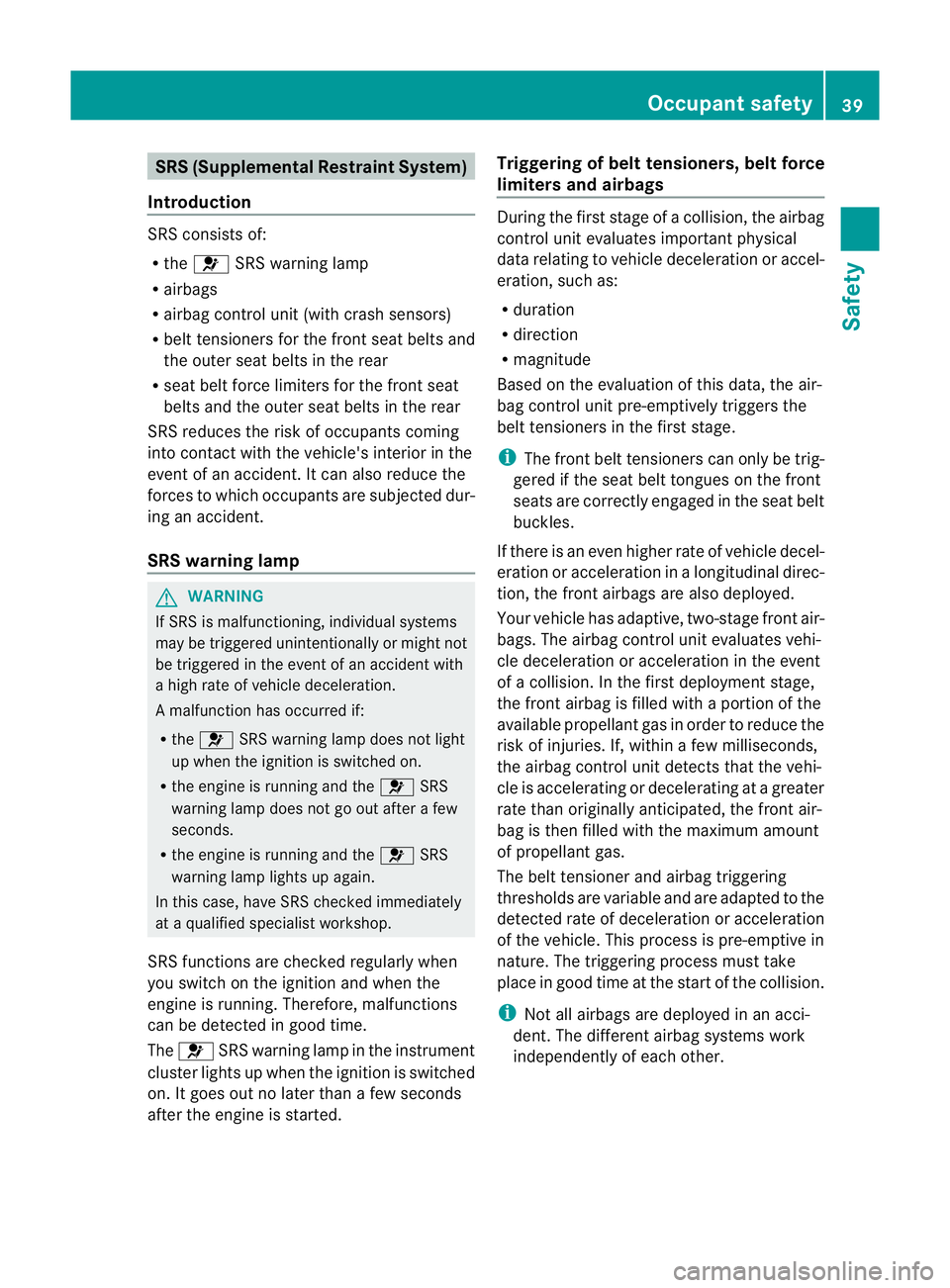
SRS (Supplemental Restraint System)
Introduction SRS consists of:
R
the 6 SRS warning lamp
R airbags
R airbag control unit (with crash sensors)
R belt tensioners for the front seat belts and
the outer seat belts in the rear
R seat belt force limiters for the front seat
belts and the outer seat belts in the rear
SRS reduces the risk of occupants coming
into contact with the vehicle's interior in the
event of an accident. It can also reduce the
forces to which occupants are subjected dur-
ing an accident.
SRS warning lamp G
WARNING
If SRS is malfunctioning, individual systems
may be triggered unintentionally or might not
be triggered in the event of an accident with
a high rate of vehicle deceleration.
A malfunction has occurred if:
R the 6 SRS warning lamp does not light
up when the ignition is switched on.
R the engine is running and the 6SRS
warning lamp does not go out after a few
seconds.
R the engine is running and the 6SRS
warning lamp lights up again.
In this case, have SRS checked immediately
at a qualified specialist workshop.
SRS functions are checked regularly when
you switch on the ignition and when the
engine is running. Therefore, malfunctions
can be detected in good time.
The 6 SRS warning lamp in the instrument
cluster lights up when the ignition is switched
on. It goes out no later than a few seconds
after the engine is started. Triggering of belt tensioners, belt force
limiters and airbags During the first stage of a collision, the airbag
control unit evaluates important physical
data relating to vehicle deceleration or accel-
eration, such as:
R
duration
R direction
R magnitude
Based on the evaluation of this data, the air-
bag control unit pre-emptively triggers the
belt tensioners in the first stage.
i The front belt tensioners can only be trig-
gered if the seat belt tongues on the front
seats are correctly engaged in the seat belt
buckles.
If there is an even higher rate of vehicle decel-
eration or acceleration in a longitudinal direc-
tion, the front airbags are also deployed.
Your vehicle has adaptive, two-stage front air-
bags. The airbag control unit evaluates vehi-
cle deceleration or acceleration in the event
of a collision. In the first deployment stage,
the front airbag is filled with a portion of the
available propellant gas in order to reduce the
risk of injuries. If, within a few milliseconds,
the airbag control unit detects that the vehi-
cle is accelerating or decelerating at a greater
rate than originally anticipated, the front air-
bag is then filled with the maximum amount
of propellant gas.
The belt tensioner and airbag triggering
thresholds are variable and are adapted to the
detected rate of deceleration or acceleration
of the vehicle. This process is pre-emptive in
nature. The triggering process must take
place in good time at the start of the collision.
i Not all airbags are deployed in an acci-
dent. The different airbag systems work
independently of each other. Occupant safety
39Safety Z
Page 46 of 329
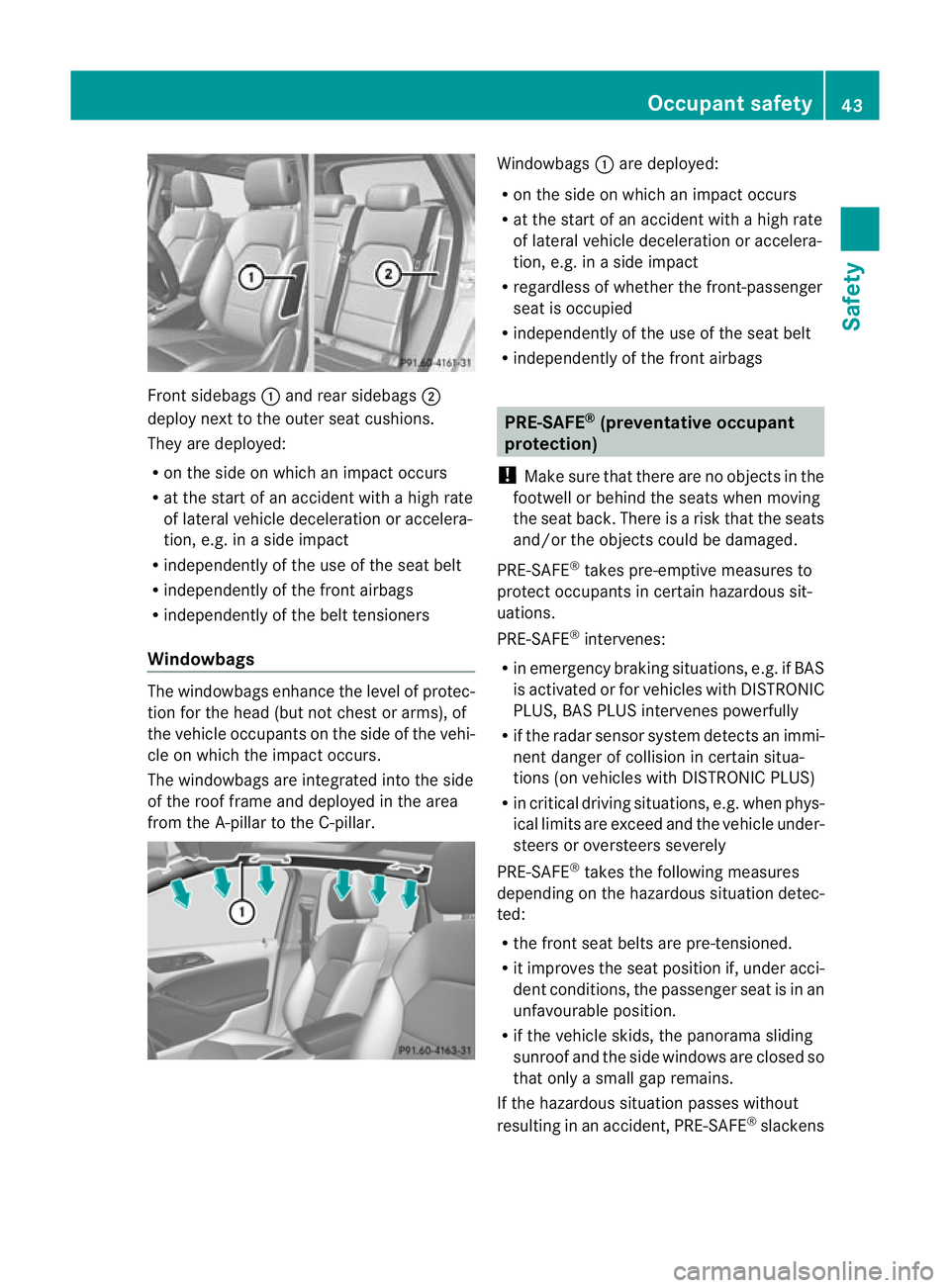
Front sidebags
:and rea rsidebags ;
deploy nex tto the outer seat cushions.
They are deployed:
R on the side on which an impact occurs
R at the start of an accident with a high rate
of lateral vehicle deceleration or accelera-
tion, e.g. in a side impact
R independently of the use of the seat belt
R independently of the front airbags
R independently of the belt tensioners
Windowbags The windowbags enhance the level of protec-
tion for the head (but not chest or arms), of
the vehicle occupants on the side of the vehi-
cle on which the impact occurs.
The windowbags are integrated into the side
of the roof frame and deployed in the area
from the A-pillar to the C-pillar. Windowbags
:are deployed:
R on the side on which an impact occurs
R at the start of an accident with a high rate
of lateral vehicle deceleration or accelera-
tion, e.g. in a side impact
R regardless of whether the front-passenger
seat is occupied
R independently of the use of the seat belt
R independently of the front airbags PRE-SAFE
®
(preventative occupant
protection)
! Make sure that there are no objects in the
footwell or behind the seats when moving
the seat back. There is a risk that the seats
and/or the objects could be damaged.
PRE-SAFE ®
takes pre-emptive measures to
protec toccupants in certain hazardous sit-
uations.
PRE-SAFE ®
intervenes:
R in emergency braking situations, e.g. if BAS
is activated or for vehicles with DISTRONIC
PLUS, BAS PLUS intervenes powerfully
R if the radar sensor system detects an immi-
nent danger of collisio nincertain situa-
tions (on vehicles with DISTRONIC PLUS)
R in critical driving situations, e.g. when phys-
ical limits are exceed and the vehicle under-
steers or oversteers severely
PRE-SAFE ®
takes the following measures
depending on the hazardous situation detec-
ted:
R the fron tseat belts are pre-tensioned.
R it improves the seat position if, under acci-
dent conditions, the passenger seat is in an
unfavourable position.
R if the vehicle skids, the panorama sliding
sunroof and the side windows are closed so
that only a small gap remains.
If the hazardous situation passes without
resulting in an accident, PRE-SAFE ®
slackens Occupant safety
43Safety Z
Page 50 of 329
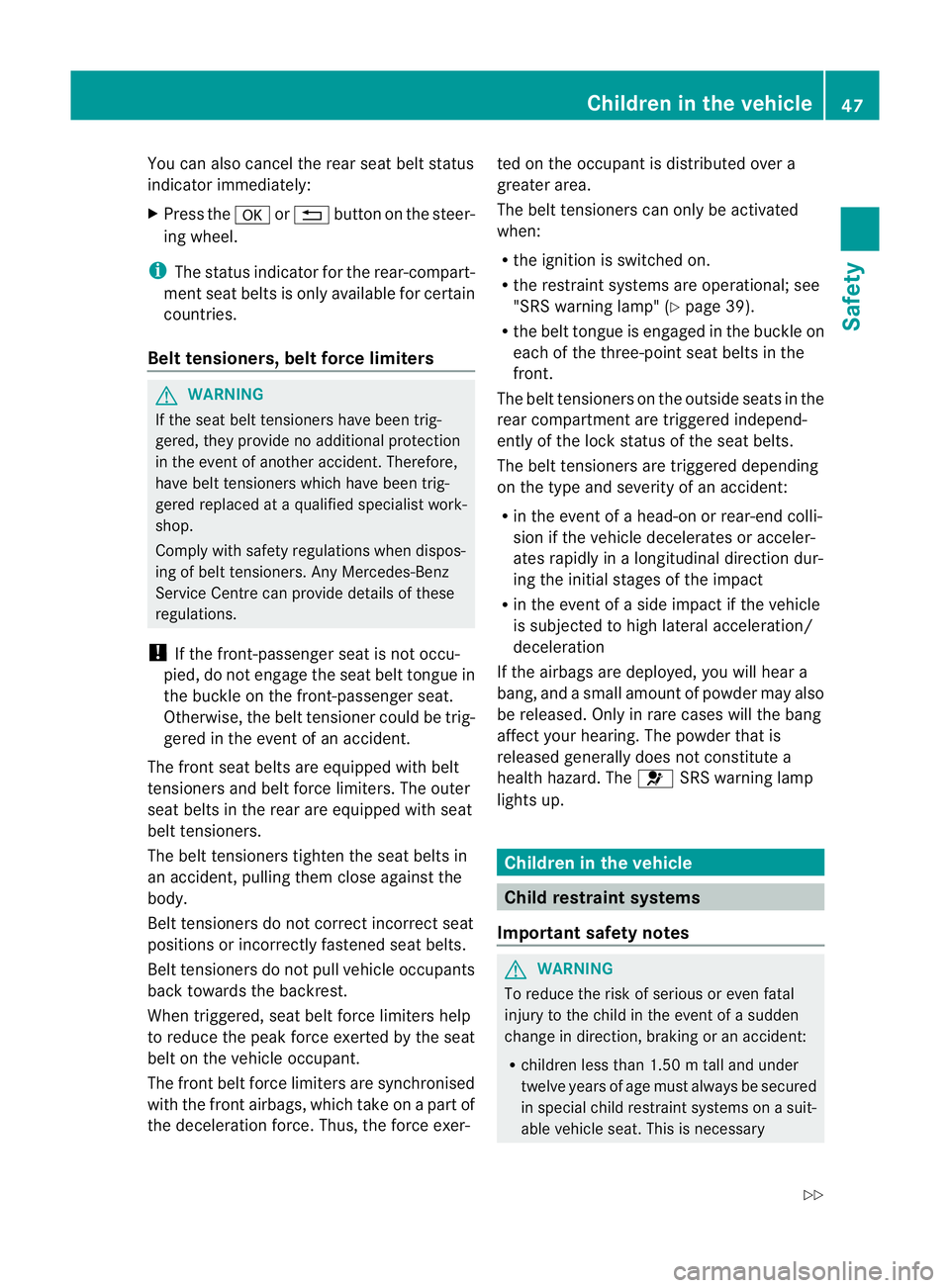
You can also cancel the rear seat belt status
indicator immediately:
X
Press the aor% button on the steer-
ing wheel.
i The status indicator for the rear-compart-
men tseat belts is only available for certain
countries.
Belt tensioners, belt force limiters G
WARNING
If the seat belt tensioners have been trig-
gered, they provide no additional protection
in the event of another accident. Therefore,
have belt tensioners which have been trig-
gered replaced at a qualified specialist work-
shop.
Comply with safety regulations when dispos-
ing of belt tensioners. Any Mercedes-Benz
Service Centre can provide details of these
regulations.
! If the front-passenger seat is not occu-
pied, do not engage the seat belt tongue in
the buckle on the front-passenger seat.
Otherwise, the belt tensioner could be trig-
gered in the event of an accident.
The fron tseat belts are equipped with belt
tensioners and belt force limiters. The outer
seat belts in the rear are equipped with seat
belt tensioners.
The belt tensioners tighten the seat belts in
an accident, pulling them close against the
body.
Belt tensioners do not correct incorrect seat
positions or incorrectly fastened seat belts.
Belt tensioners do not pull vehicle occupants
back towards the backrest.
When triggered, seat belt force limiters help
to reduce the peak forc eexerted by the seat
belt on the vehicle occupant.
The front belt force limiters are synchronised
with the front airbags, which take on a part of
the deceleratio nforce. Thus, the force exer- ted on the occupant is distributed over a
greater area.
The belt tensioners can only be activated
when:
R the ignition is switched on.
R the restraint systems are operational; see
"SRS warning lamp" (Y page 39).
R the belt tongue is engaged in the buckle on
each of the three-point seat belts in the
front.
The belt tensioners on the outside seats in the
rear compartment are triggered independ-
ently of the lock status of the seat belts.
The belt tensioners are triggered depending
on the type and severity of an accident:
R in the event of a head-on or rear-end colli-
sion if the vehicle decelerates or acceler-
ates rapidly in a longitudinal direction dur-
ing the initial stages of the impact
R in the event of a side impact if the vehicle
is subjected to high lateral acceleration/
deceleration
If the airbags are deployed, you will hear a
bang, and a small amount of powder may also
be released. Only in rare cases will the bang
affect your hearing. The powder that is
released generally does not constitute a
health hazard. The 6SRS warning lamp
lights up. Children in the vehicle
Child restraint systems
Important safety notes G
WARNING
To reduce the risk of serious or even fatal
injury to the child in the event of a sudden
change in direction, braking or an accident:
R children less than 1.50 m tall and under
twelve years of age must always be secured
in special child restraint systems on a suit-
able vehicle seat. This is necessary Children in the vehicle
47Safety
Z
Page 51 of 329
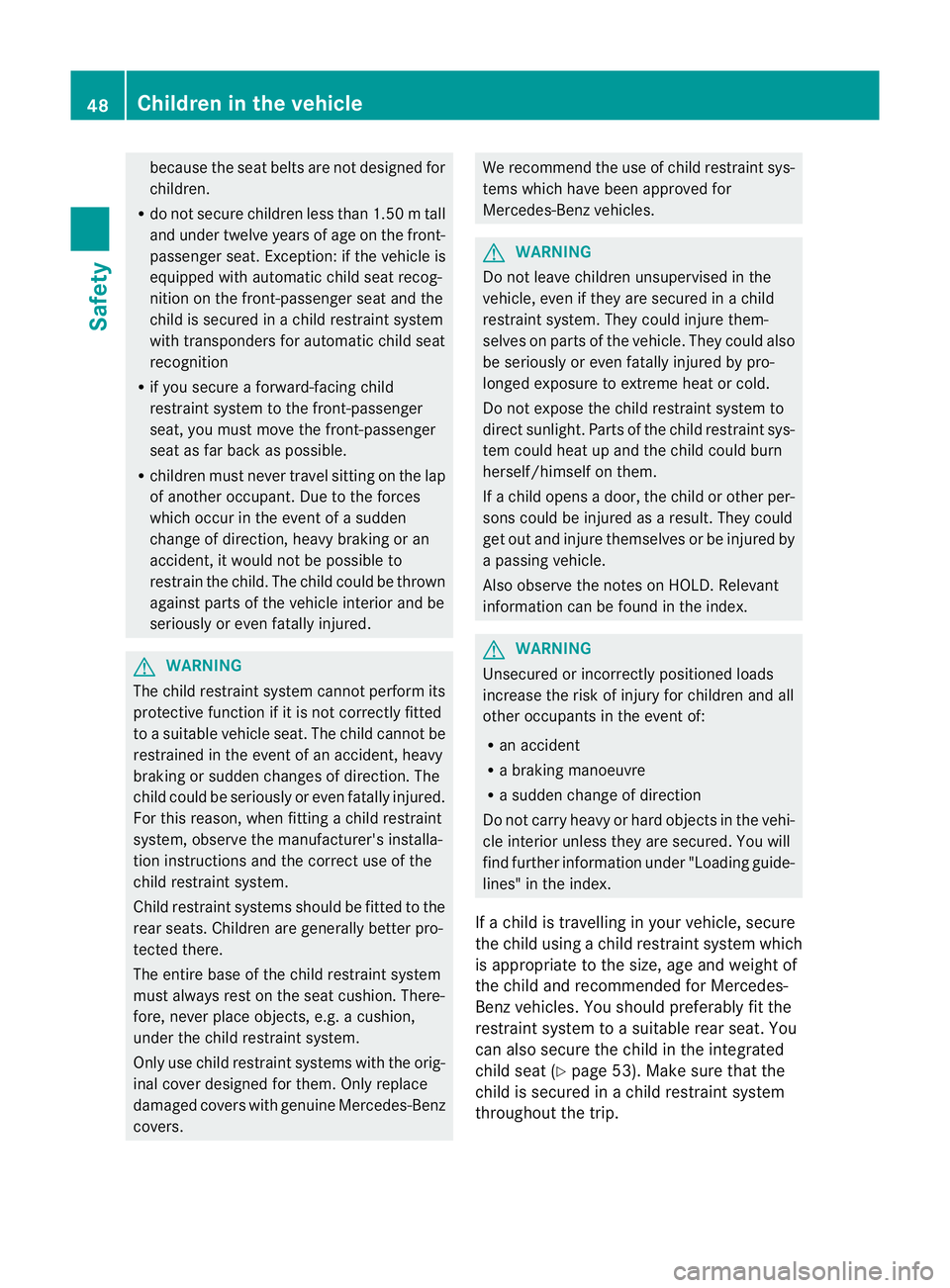
because the seat belts are not designed for
children.
R do not secure children less than 1.5 0mtall
and under twelve years of age on the front-
passenge rseat. Exception :ifthe vehicle is
equipped with automatic child seat recog-
nition on the front-passenger seat and the
child is secured in a child restraint system
with transponders for automatic child seat
recognition
R if you secure a forward-facing child
restraint system to the front-passenger
seat, you must move the front-passenger
seat as far back as possible.
R children must never travel sitting on the lap
of another occupant. Due to the forces
which occur in the event of a sudden
change of direction, heavy braking or an
accident, it would not be possible to
restrain the child. The child could be thrown
against parts of the vehicle interior and be
seriously or even fatally injured. G
WARNING
The child restraint system cannot perform its
protective function if it is not correctly fitted
to a suitable vehicle seat. The child cannot be
restrained in the event of an accident, heavy
braking or sudden changes of direction. The
child could be seriously or even fatally injured.
For this reason, when fitting a child restraint
system, observe the manufacturer's installa-
tion instructions and the correct use of the
child restraint system.
Child restraint systems should be fitted to the
rear seats. Children are generally better pro-
tected there.
The entire base of the child restraint system
must always rest on the seat cushion. There-
fore, never place objects, e.g. a cushion,
under the child restraint system.
Only use child restraint systems with the orig-
inal cover designed for them. Only replace
damaged covers with genuine Mercedes-Benz
covers. We recommend the use of child restraint sys-
tems which have been approved for
Mercedes-Ben
zvehicles. G
WARNING
Do not leave children unsupervised in the
vehicle, even if they are secured in a child
restraint system. They could injure them-
selves on parts of the vehicle. They could also
be seriously or even fatally injured by pro-
longed exposure to extreme heat or cold.
Do not expose the child restraint system to
direct sunlight. Parts of the child restraint sys-
tem could heat up and the child could burn
herself/himself on them.
If a child opens a door, the child or other per-
sons could be injured as a result. They could
get out and injure themselves or be injured by
a passing vehicle.
Also observe the notes on HOLD .Relevant
information can be found in the index. G
WARNING
Unsecured or incorrectly positioned loads
increase the risk of injury for children and all
other occupants in the event of:
R an accident
R a braking manoeuvre
R a sudden change of direction
Do not carry heavy or hard objects in the vehi-
cle interior unless they are secured. You will
find further information under "Loading guide-
lines" in the index.
If a child is travelling in your vehicle, secure
the child using a child restraint system which
is appropriate to the size, age and weight of
the child and recommended for Mercedes-
Benz vehicles. You should preferably fit the
restraint system to a suitable rear seat. You
can also secure the child in the integrated
child seat (Y page 53). Make sure that the
child is secured in a child restraint system
throughout the trip. 48
Children in the vehicleSafety
Page 54 of 329
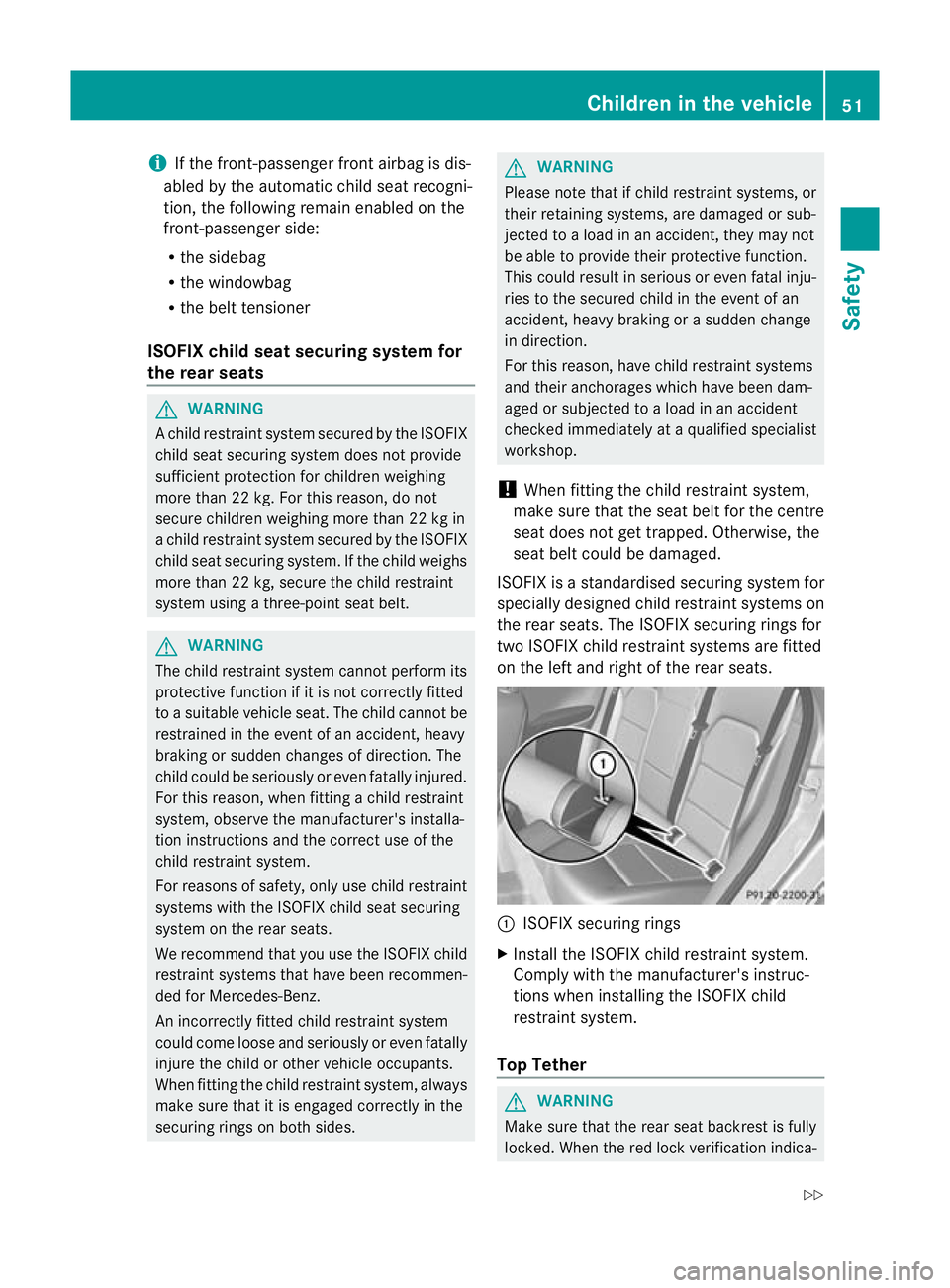
i
If the front-passenger front airbag is dis-
abled by the automatic child seat recogni-
tion, the following remaine nabled on the
front-passenger side:
R the sidebag
R the windowbag
R the belt tensioner
ISOFIX chil dseat securing system for
the rear seats G
WARNING
Ac hild restraint system secured by the ISOFIX
child seat securing system does not provide
sufficient protection for children weighing
more than 22 kg. For this reason, do not
secure children weighing more than 22 kg in
a child restraint system secured by the ISOFIX
child seat securing system. If the child weighs
more than 22 kg, secure the child restraint
system using a three-point seat belt. G
WARNING
The child restraint system cannot perform its
protective function if it is not correctly fitted
to a suitable vehicle seat. The child cannot be
restrained in the event of an accident, heavy
braking or sudden changes of direction. The
child could be seriously or even fatally injured.
For this reason, when fitting a child restraint
system, observe the manufacturer's installa-
tion instructions and the correct use of the
child restraint system.
For reasons of safety, only use child restraint
systems with the ISOFIX child seat securing
system on the rear seats.
We recommend that you use the ISOFIX child
restraint systems that have been recommen-
ded for Mercedes-Benz.
An incorrectly fitted child restraint system
could come loose and seriously or even fatally
injure the child or other vehicle occupants.
When fitting the child restraint system, always
make sure that it is engaged correctly in the
securing rings on both sides. G
WARNING
Please note that if child restraint systems, or
their retaining systems, are damaged or sub-
jected to a load in an accident, they may not
be able to provide their protective function.
This could result in serious or even fatal inju-
ries to the secured child in the event of an
accident, heavy braking or a sudden change
in direction.
For this reason, have child restraint systems
and their anchorages which have been dam-
aged or subjected to a load in an accident
checked immediately at a qualified specialist
workshop.
! When fitting the child restraint system,
make sure that the seat belt for the centre
seat does not get trapped. Otherwise, the
seat belt could be damaged.
ISOFIX is a standardised securing system for
specially designed child restraint systems on
the rear seats. The ISOFIX securing rings for
two ISOFIX child restraint systems are fitted
on the left and right of the rear seats. :
ISOFIX securing rings
X Install the ISOFIX child restraint system.
Comply with the manufacturer's instruc-
tions when installing the ISOFIX child
restraint system.
Top Tether G
WARNING
Make sure that the rear seat backrest is fully
locked. When the red lock verification indica- Children in the vehicle
51Safety
Z
Page 56 of 329
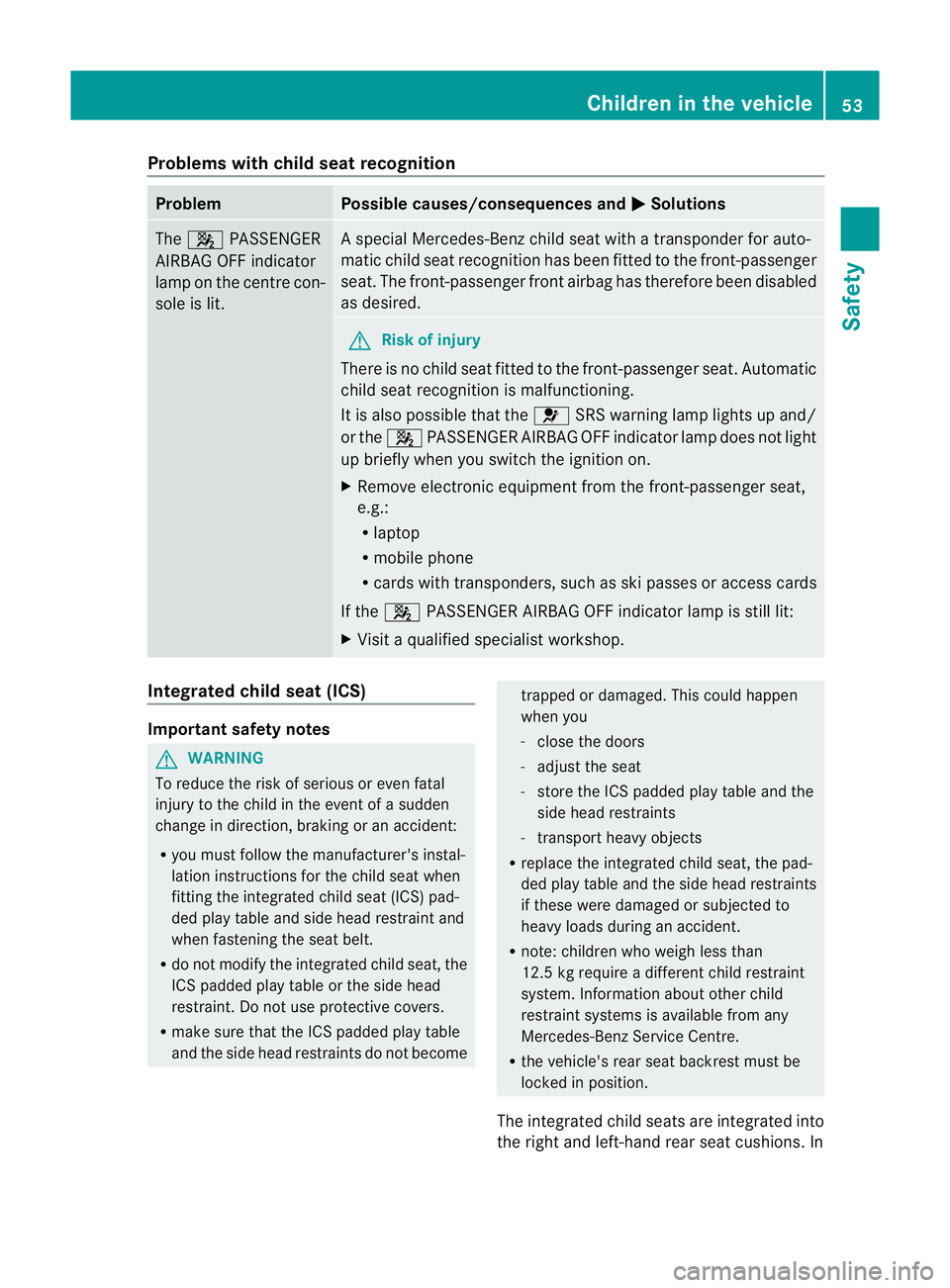
Problems with child seat recognition
Problem Possible causes/consequences and
M Solutions
The
4 PASSENGER
AIRBAG OFF indicator
lamp on the centre con-
sole is lit. As
pecial Mercedes-Benz child seat with a transponder for auto-
matic child seat recognition has been fitted to the front-passenger
seat. The front-passenger fron tairbag has therefore been disabled
as desired. G
Risk of injury
There is no child seat fitted to the front-passenger seat .Automatic
child seat recognition is malfunctioning.
It is also possible that the 6SRS warning lamp light sup and/
or the 4PASSENGER AIRBAG OFF indicator lamp does not light
up briefly when you switch the ignition on.
X Remove electronic equipment from the front-passenger seat,
e.g.:
R
laptop
R mobile phone
R cards with transponders, such as ski passes or access cards
If the 4 PASSENGER AIRBAG OFF indicator lamp is still lit:
X Visit a qualified specialist workshop. Integrated child seat (ICS)
Important safety notes
G
WARNING
To reduce the risk of serious or even fatal
injury to the child in the event of a sudden
change in direction, braking or an accident:
R you must follow the manufacturer's instal-
lation instructions for the child seat when
fitting the integrated child seat (ICS) pad-
ded play table and side head restraint and
when fastening the seat belt.
R do not modify the integrated child seat, the
ICS padded play table or the side head
restraint. Do not use protective covers.
R make sure that the ICS padded play table
and the side head restraints do not become trapped or damaged. This could happen
when you
- close the doors
- adjust the seat
- store the ICS padded play table and the
side head restraints
- transport heavy objects
R replace the integrated child seat, the pad-
ded play table and the side head restraints
if these were damaged or subjected to
heavy loads during an accident.
R note: children who weigh less than
12.5 kg require a different child restraint
system. Information about other child
restraint systems is available from any
Mercedes-Benz Service Centre.
R the vehicle's rear seat backrest must be
locked in position.
The integrated child seats are integrated into
the right and left-hand rear seat cushions. In Children in the vehicle
53Safety Z
Page 58 of 329
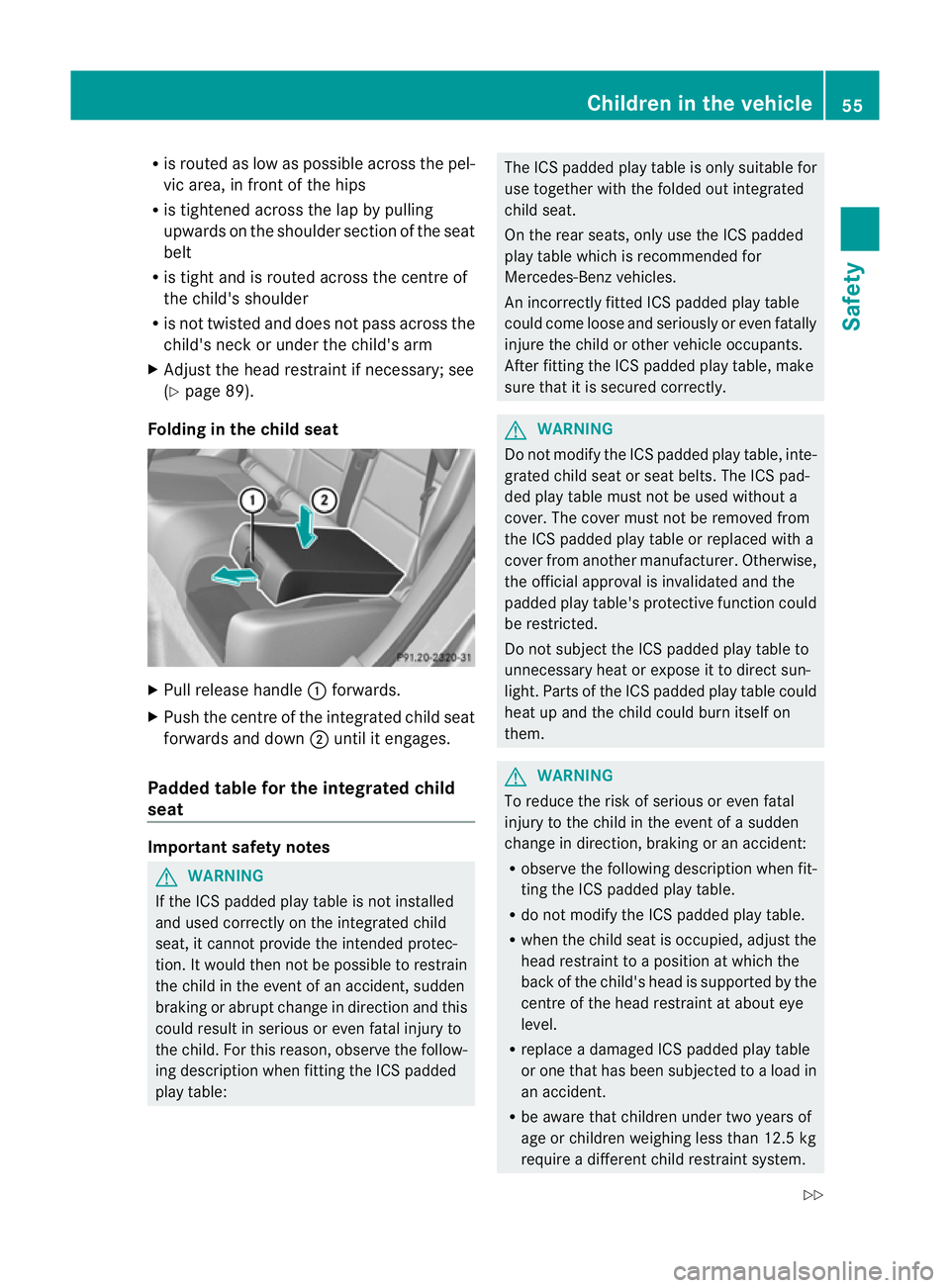
R
is routed as low as possible across the pel-
vic area, in front of the hips
R is tightened across the lap by pulling
upwards on the shoulder section of the seat
belt
R is tigh tand is routed across the centre of
the child's shoulder
R is not twisted and does not pass across the
child's neck or under the child's arm
X Adjust the head restraint if necessary; see
(Y page 89).
Folding in the chil dseat X
Pull release handle :forwards.
X Push the centre of the integrated child seat
forwards and down ;until it engages.
Padded table for the integrated child
seat Important safety notes
G
WARNING
If the ICS padded play table is not installed
and used correctly on the integrated child
seat, it cannot provide the intended protec-
tion. It would then not be possible to restrain
the child in the even tofanaccident, sudden
braking or abrup tchange in direction and this
could result in serious or even fatal injury to
the child. For this reason, observe the follow-
ing description when fitting the ICS padded
play table: The ICS padded play table is only suitable for
use together with the folded out integrated
child seat.
On the rear seats, only use the ICS padded
play table which is recommended for
Mercedes-Ben
zvehicles.
An incorrectly fitted ICS padded play table
could come loose and seriously or even fatally
injure the child or other vehicle occupants.
After fitting the ICS padded play table, make
sure that it is secured correctly. G
WARNING
Do not modify the ICS padded play table, inte-
grated child seat or seat belts. The ICS pad-
ded play table must not be used without a
cover. The cover must not be removed from
the ICS padded play table or replaced with a
cover from another manufacturer. Otherwise,
the official approval is invalidated and the
padded play table's protective function could
be restricted.
Do not subject the ICS padded play table to
unnecessary heat or expose it to direct sun-
light. Parts of the ICS padded play table could
heat up and the child could burn itself on
them. G
WARNING
To reduce the risk of serious or even fatal
injury to the child in the event of a sudden
change in direction, braking or an accident:
R observe the following description when fit-
ting the ICS padded play table.
R do not modify the ICS padded play table.
R when the child seat is occupied, adjust the
head restraint to a position at which the
back of the child's head is supported by the
centre of the head restraint at about eye
level.
R replace a damaged ICS padded play table
or one that has been subjected to a load in
an accident.
R be aware that children under two years of
age or children weighing less than 12.5kg
require a different child restraint system. Children in the vehicle
55Safety
Z